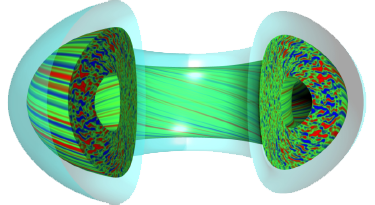Speaker
Description
DATA-DRIVEN DISCOVERY APPROACH TO TACKLE TURBULENCE IN FUSION PLASMA
Salazar Luigui
University of Lorraine - CNRS
54000 Nancy, France
CEA, IRFM
13108 Saint Paul lez Durance, France
Email: luigui.salazar@cea.fr
Stéphane HEURAUX
University of Lorraine - CNRS
54000 Nancy, France
Roland SABOT
CEA, IRFM
13108 Saint Paul lez Durance, France
Abstract
The identification of turbulence sources could prove to be advantageous for a deeper understanding of dynamics in magnetic confinement in fusion devices. The aim of this work is to obtain a database from reflectometry (a technique based on the radar principle) raw signals, ready to be analyzed with the purpose of investigating turbulence behavior and its dynamics.
A systematic study, based on data from the Tore Supra tokamak, has been carried out as part of a PhD (Yan Sun's work ) in order to extract general trends according to a set of parameters (from thousands of parameters to eleven associated with the frequency spectrum decomposition). The spectrum decomposition follows models as Generalized Gaussian function and Lorenztian function and there are 4 components: Carrier component, Low frequency fluctuations, Broadband turbulence and the noise. However, despite the significant parameter reduction, this systematic study has some limitations as the assumption of stationary turbulence and the setting of the component frequency threshold and range in advance.
This study is born out of the necessity of removing the ad-hoc frequency range of the components, overcoming these stationary issues and thereby enabling a description of the energy exchange among of the different components in a context of non-stationary turbulence.
The main idea is to combine the approach of signal processing with artificial intelligence: the continuous wavelet transform has proven to be efficient in providing a decomposition of signal at different scales over time. The time-scale representation (image) produced enables the visualization of some patterns evolving with the time. These patterns are present on a range of defined scales, avoiding setting the frequency range in advance; the convolutional auto-encoder neural network is responsible for taking these produced images for automatic identification of every pattern. This automatic process is based on threshold learning, with a large quantity of signals.
This current study aims to remove smartly the identified patterns in order to get a “clean-up” frequency spectrum, making it possible to focus only on the Broadband turbulence component, more precisely on its internal structure and dynamics.
This intelligent process has the potential to make a turbulence source(s) identification (frequency ranges) and their interplay in real-time, so this can be applied to data from the West tokamak in the near future.
| Country or International Organisation | France |
|---|---|
| Affiliation | Universite de Lorraine, 54000 - Nancy |

